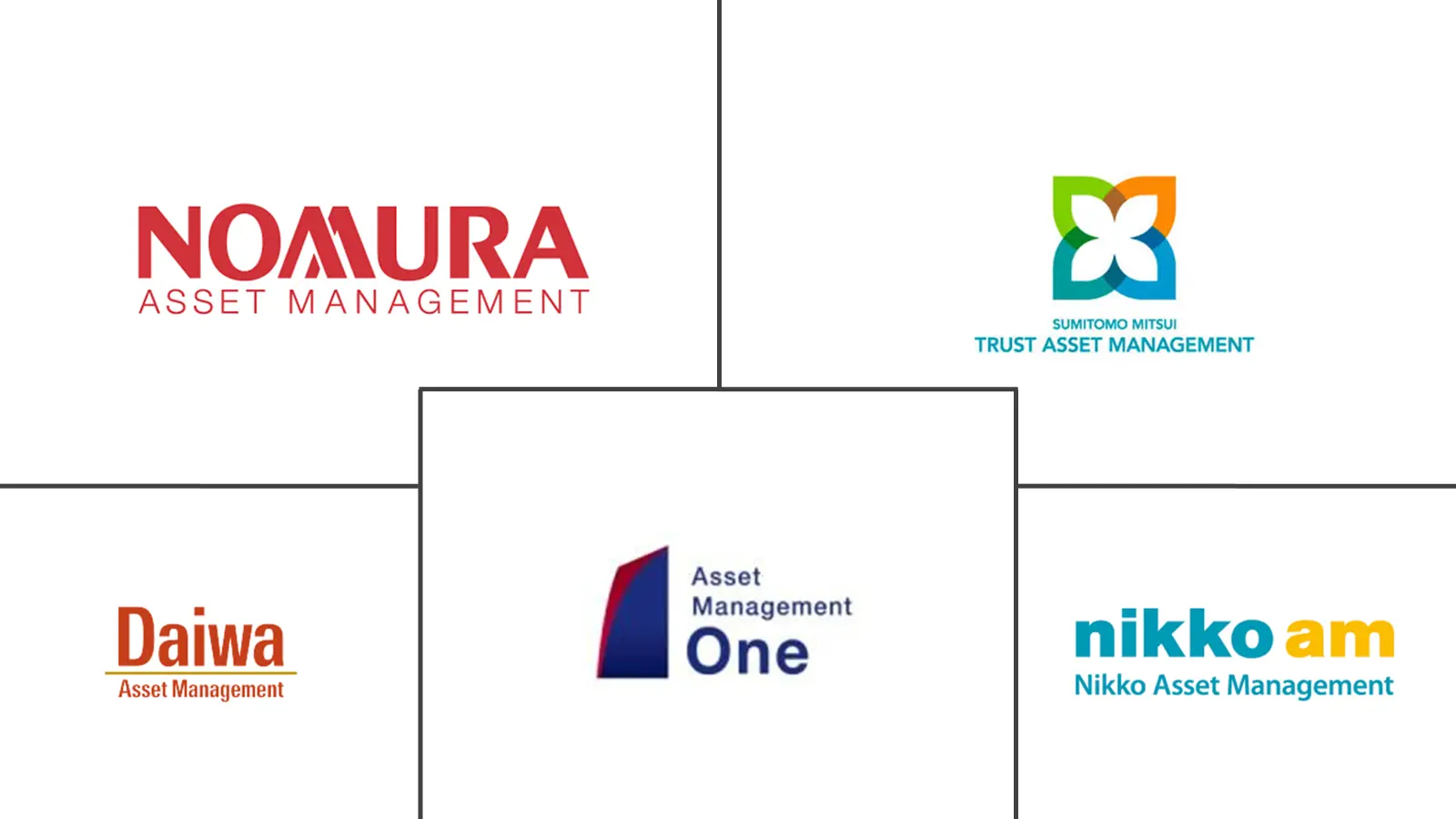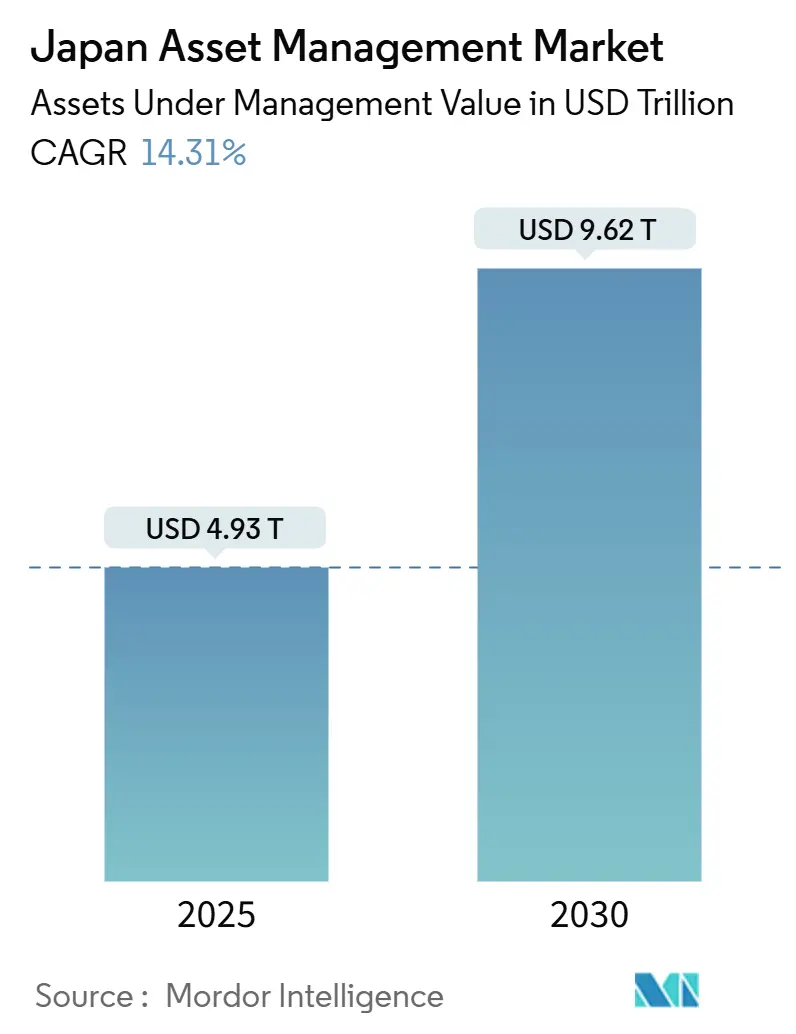
Japan Asset Management Market Analysis by Mordor Intelligence
The Japan asset management market value stands at USD 4.93 trillion in 2025 and is forecast to reach USD 9.62 trillion by 2030, expanding at a 14.31% CAGR. The upward trajectory reflects a decisive move away from a cash-heavy household balance sheet toward professionally managed investments, such as corporate pension reform, tax-advantaged NISA upgrades, and the Government Pension Investment Fund’s (GPIF) alternative-asset strategy combine to lift net inflows. Digital onboarding, rising demand for outcome-oriented strategies, and the 2024 exit from negative interest rates further accelerate the adoption of investment products. Competitive intensity remains moderate because the Japan asset management market is still fragmented, allowing specialist houses and foreign entrants to carve out niches. Managers able to modernize legacy technology and align with environmental, social, and governance (ESG) standards appear best placed to capture share as demographic pressure prompts investors to seek higher-yielding, globally diversified portfolios.
Key Report Takeaways
- By asset class, equity products led with a 42.3% share of the Japan asset management market in 2024, while alternative assets are projected to expand at a 16.42% CAGR to 2030.
- By firm type, banks held 45.7% of the Japan asset management market share in 2024, whereas wealth advisory firms are expected to record the fastest projected CAGR at 15.87% through 2030.
- By mode of advisory, human advisers retained 91.2% share of the Japan asset management market size in 2024; robo-advisers are expected to grow at a 20.23% CAGR to 2030.
- By client type, institutional investors commanded 71.3% of the Japan asset management market size in 2024, while the retail segment is forecasted to rise at a 17.45% CAGR.
- By management source, onshore managers controlled 85.6% of the Japan asset management market size in 2024; offshore-delegated mandates are set to increase at a 16.95% CAGR through 2030.
Japan Asset Management Market Trends and Insights
Drivers Impact Analysis
| Driver | (~) % Impact on CAGR Forecast | Geographic Relevance | Impact Timeline |
|---|---|---|---|
| Accelerating the shift from bank deposits to investment funds | +3.20% | National – concentration in Tokyo and Osaka | Medium term (2–4 years) |
| Mandatory corporate pension reform boosting AUM inflows | +2.80% | National – early adoption by large corporations | Short term (≤ 2 years) |
| Robo-advisory adoption among mass-affluent investors | +1.90% | National – higher penetration in urban areas | Medium term (2–4 years) |
| GPIF’s alternative-asset appetite is setting industry benchmarks | +2.10% | National – spillover to regional pension funds | Long term (≥ 4 years) |
| Tokenized securities pilots opening new investable asset pools | +1.40% | National – early roll-out in the Tokyo financial district | Long term (≥ 4 years) |
| ESG transition bonds fueling specialized fund launches | +1.70% | National – international capital participation | Medium term (2–4 years) |
| Source: Mordor Intelligence | |||
Accelerating the shift from bank deposits to investment funds
Japanese households keep a large share of their wealth in cash, yet the revamped NISA program now lets individuals invest sizable sums each year without paying tax, redirecting part of those idle balances into capital markets. The Bank of Japan’s decision in 2024 to end negative interest rates made equities and balanced funds more attractive than simply parking money in savings accounts. The government’s goal of significantly expanding NISA participation further anchors long-term demand for mutual funds and exchange-traded funds. Large banks and securities groups are pouring resources into digital client platforms; for example, Mizuho has committed major capital to tools that nudge savers toward diversified portfolios. Managers that pair clear, low-cost fee structures with robust investor education are positioned to capture a disproportionate share of these new flows as risk-averse savers move toward professionally managed solutions.
Mandatory corporate pension reform boosting AUM inflows
Legislation requiring defined contribution (DC) plans is shifting longevity risk from corporate balance sheets to professional managers. Early movers among large manufacturers and service conglomerates are migrating legacy defined-benefit assets into professionally run DC schemes, providing multi-year visibility on fee revenue. GPIF’s ESG integration template is increasingly mirrored by corporate funds, prompting demand for multi-asset, inflation-hedged, and sustainability-aligned strategies[1]Government Pension Investment Fund, “Annual Investment Policy and ESG Report 2025,” gpif.go.jp. As reforms broaden across mid-sized companies, asset managers offering bundled record-keeping, participant education, and outcome-oriented product menus can cement institutional relationships and achieve scalable growth.
Robo-advisory adoption among mass-affluent investors
WealthNavi achieved significant growth in client assets through an intuitive digital interface that lowers the minimum investment threshold to JPY 10,000 and automates global portfolio construction. Younger professionals gravitate toward app-based onboarding and transparent pricing, accelerating household penetration of passive and low-cost diversified products. MUFG's USD 664 million purchase of WealthNavi highlights the race among incumbents to secure digital capabilities. Hybrid models combining algorithmic core portfolios with optional human guidance are emerging, enabling managers to address simple accumulation goals and more complex life-stage planning within one ecosystem. Robo adoption thus broadens the addressable retail base for the Japan asset management market.
GPIF’s alternative-asset appetite is setting industry benchmarks
GPIF pledged to raise alternatives from 1.5% to 5% of its portfolio by 2030 and recently committed USD 500 million to a global private-equity mandate[2]Pensions & Investments, “GPIF Commits to Thoma Bravo Fund,” pionline.com. Because corporate pension trustees often emulate GPIF allocations, the decision catalyzes fresh demand for infrastructure, real estate, and private-equity vehicles. Domestic managers are launching funds that match Japanese liability profiles, while global specialists enter joint ventures to provide local investors with established overseas pipelines. The demonstration effect elevates governance standards, fee transparency, and risk-management practices across the Japan asset management market and widens the investable universe for return-seeking institutions.
Restraints Impact Analysis
| Restraint | (~) % Impact on CAGR Forecast | Geographic Relevance | Impact Timeline |
|---|---|---|---|
| Persistent near-zero interest-rate environment compressing yields | -1.80% | National – strongest effect on fixed-income strategies | Short term (≤ 2 years) |
| Shrinking working-age population limiting contribution growth | -2.10% | National – most acute in rural regions | Long term (≥ 4 years) |
| Legacy mainframe systems slowing product-launch cycles | -1.20% | National – concentrated in established institutions | Medium term (2–4 years) |
| High distribution fees discouraging retail switching | -0.90% | National – pronounced in independent advisory channels | Short term (≤ 2 years) |
| Source: Mordor Intelligence | |||
Persistent near-zero interest-rate environment compressing yields
Although the Bank of Japan ended negative rates, policy remains accommodative, leaving domestic bond yields subdued and eroding traditional income streams. Asset managers must search for yield in overseas credit, infrastructure debt, and dividend-oriented equities, but smaller firms lack the global research footprint or risk infrastructure to implement these ideas competitively. This environment favors diversified houses with international reach and sophisticated hedging capabilities, widening performance dispersion and posing retention risks for legacy bond-heavy franchises.
Shrinking working-age population limiting long-term contribution growth
The national workforce is projected to contract steadily, reducing payroll-based retirement contributions and curbing organic asset-gathering momentum, particularly in prefectures outside major urban corridors. Asset managers need to compensate by deepening wallet share with existing clients, enhancing productivity through technology, and attracting foreign capital. Firms able to package retirement solutions for older demographics—such as income-drawdown products and decumulation planning—can mitigate the demographic drag and sustain relevance in the Japan asset management market.
Segment Analysis
By Asset Class: Alternative assets gain momentum
Equities accounted for 42.4% of the Japan asset management market size in 2024, underscoring the historical bias toward domestic stock exposure fostered by decades of familiarity with the Nikkei and TOPIX indices. The Japan asset management market size tied to alternative strategies is forecasted to rise by 16.42% annually, outpacing every traditional asset class as return expectations compress in public markets. GPIF mandates, corporate pension copycat allocations, and the search for long-duration inflation-protected cash flows are shaping demand. Real estate, infrastructure, and private equity funds designed around the government’s Green Transformation roadmap slot naturally into this narrative, enabling institutions to match liability profiles while supporting domestic growth initiatives.
In response, local managers are building specialist teams or entering partnerships with global alternative houses to secure deal flow and operational expertise. Foreign firms with established global platforms are leveraging Tokyo branches to distribute seasoned funds that offer currency-hedged share classes and local reporting. Competitive differentiation is shifting toward sourcing capabilities and governance transparency rather than headline performance alone, a pattern that realigns fee structures with value delivered in the Japan asset management market.
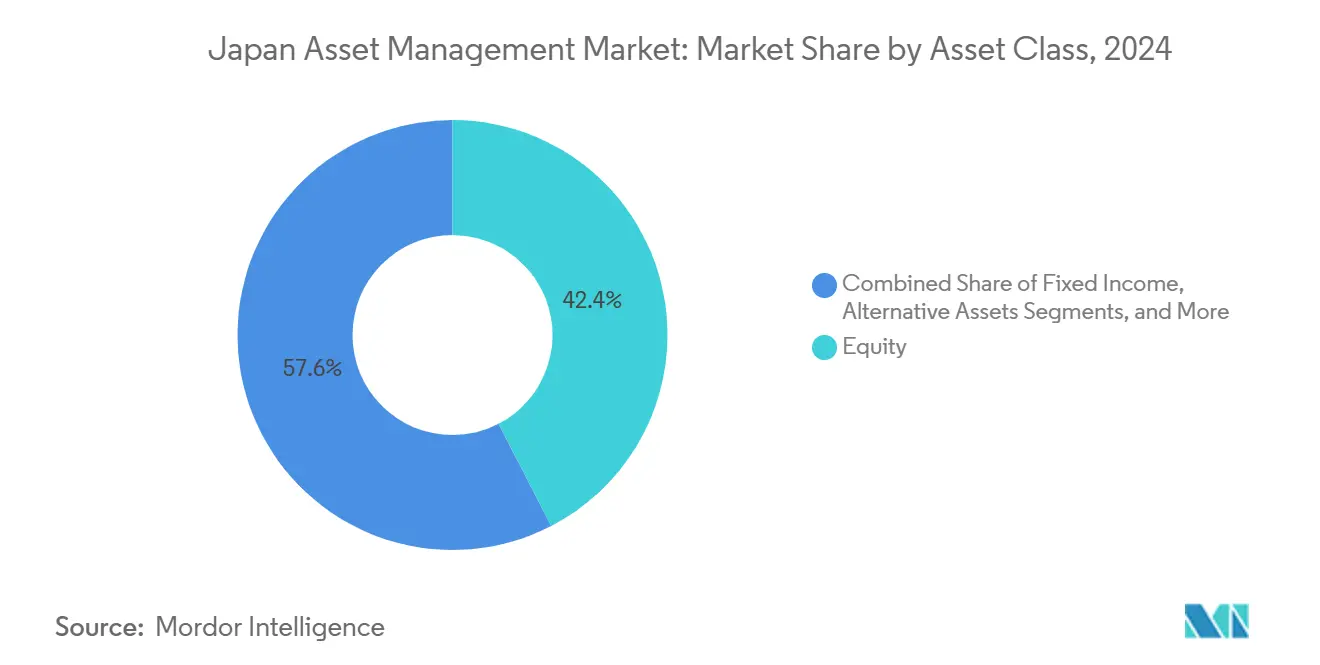
Note: Segment shares of all individual segments available upon report purchase
By Firm Type: Banks retain scale; specialists accelerate
Banks held 45.7% of the Japan asset management market size in 2024, courtesy of sprawling branch networks, but their share inches down as new investors gravitate to independent advisers touting fiduciary standards. Wealth advisory companies are projected to record a 15.87% CAGR through 2030, indicating that advice quality and perceived objectivity matter more than one-stop convenience. In the Japan asset management market, this trend forces banks to unbundle pricing, enhance product due diligence, and invest in staff training to meet heightened suitability standards.
Specialist boutiques leverage thematic expertise—ESG equities, small-cap activist funds, private credit—to attract sophisticated clients willing to pay for differentiated alpha. Broker-dealers sit between banks and pure advisers by combining research depth with transactional agility, but fee compression in execution services nudges them toward higher-margin advisory mandates. Overall, a multi-channel equilibrium is emerging in which breadth, depth, and digital engagement coexist, keeping competitive barriers in flux.
By Mode of Advisory: Hybrid dominates the transition
Human advisers accounted for 91.2% of the Japan asset management market size in 2024, anchored by culture and the complexity of many retirement portfolios. Nevertheless, robo platforms compound at 20.23% annually, targeting mass-affluent cohorts who prize simplicity, low cost, and mobile-first functionality. The MUFG-WealthNavi deal crystallizes the shift toward integrated models that combine algorithmic core portfolios with access to human planners for event-driven advice.
Hybrid propositions lower delivery cost while preserving the reassurance that older investors value, enabling incumbents to defend relationships against pure-play fintech challengers. For the Japan asset management market, the winning formula centers on seamless app experiences, straight-through processing, and clear delineation of fees. Regulators, seeking broader retail participation, implicitly support these models by tightening disclosure rules on commission-laden products and by endorsing digital identity verification tools[4]Japan Financial Services Agency, “Strategy for Becoming an International Asset Management Center,” fsa.go.jp.
By Client Type: Retail uptake narrows the institutional gap
Institutional mandates constitute 71.3% of the Japan asset management market size in 2024, a figure reflecting pension, insurance, and reserve assets that prize scale economies and robust governance. Retail assets, however, grow at 17.45% CAGR thanks to the overhauled NISA regime, expanded financial-literacy campaigns, and user-friendly digital onboarding. The government targets to double NISA account penetration, anchor this trajectory, ensuring a steady pipeline of novice investors seeking diversified funds.
Asset managers pivot by creating low-minimum-investment share classes and extensive educational content. Banks and securities companies deploy integrated dashboards that present savings, brokerage, and credit products on a single screen, helping clients monitor progress toward long-term goals. As household portfolios diversify, cross-selling potential rises, aiding revenue resilience amid fee compression elsewhere in the Japan asset management market.
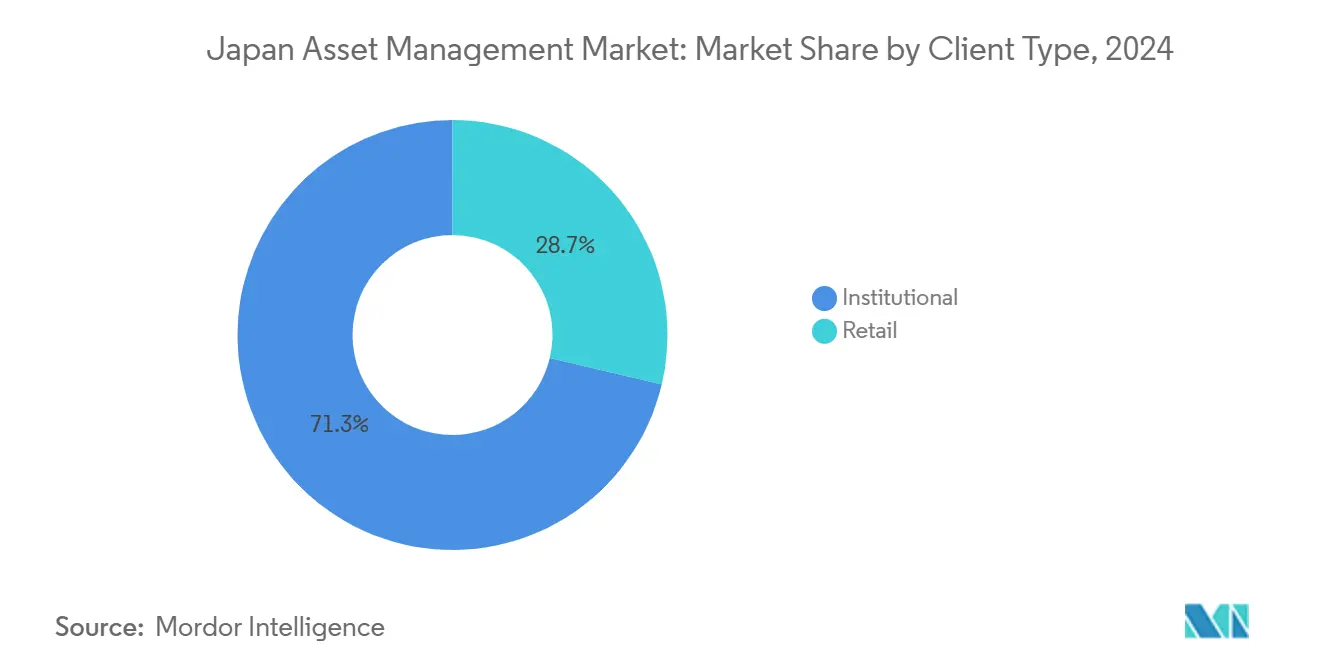
Note: Segment shares of all individual segments available upon report purchase
By Management Source: Onshore dominance meets outward diversification
Onshore entities accounted for 85.6% of the Japan asset management market size in 2024, reflecting regulatory familiarity and cultural bias toward domestic stewardship. Yet, mandates are expected to drive the offshore segment 16.95% annually through 2030, as institutions pursue geographic diversification, higher yields, and specialist know-how. Currency-hedged share classes and index-aware overlays make foreign investments palatable for trustees wary of volatility.
Japanese managers react by opening research outposts in New York, London, and Singapore or by signing sub-advisory pacts with international specialists. Global houses deepen Tokyo operations to satisfy local due diligence expectations and partner with trust banks for distribution. As a result, the Japan asset management market tightens its links to global capital flows while maintaining local governance anchors.
Geography Analysis
Tokyo hosts the majority of asset managers, regulators, and service providers, creating network benefits that reinforce its standing as the nation’s financial epicenter. Osaka ranks as a secondary hub, leveraging historical bank and insurance headquarters to serve western prefectures. Outside these metros, regional banks and credit unions dominate savings pools but lack product breadth, offering entry points for managers willing to extend digital advisory and remote service models.
Government strategy to position the country as a premier international asset management center catalyzes infrastructure upgrades—English documentation, streamlined licensing, and favorable tax treatment—geared toward attracting foreign talent and capital. Pilot zones for fintech innovation in Fukuoka and Sapporo aim to disperse opportunities beyond the capital while supporting nationwide digitization.
Natural disaster risk in the Kanto region propels contingency planning; institutions diversify data-center footprints and encourage flexible work arrangements to ensure continuity. Meanwhile, aging demographics skew more sharply in rural areas, prompting targeted outreach programs that pair digital education with mobile advisory units. Geographic segmentation, therefore, amplifies the scope for differentiated distribution strategies within the Japan asset management market.
Competitive Landscape
The Japan asset management market remains moderately fragmented, leaving room for consolidation and foreign entry. Domestic heavyweights such as Nomura, Daiwa, and Sumitomo Mitsui Trust posted record ordinary income for FY2024 as market reform and rising risk appetite lifted fee revenues. Foreign firms enlarge their footprints through acquisitions and joint ventures to capture thematic demand and alternative-asset interest.
Strategic priorities cluster around technology enablement, ESG integration, and alternative capability build-outs. Nomura's USD 1.8 billion purchase of Macquarie's U.S. and European public-asset unit expanded its global AUM base. MUFG's integration of WealthNavi secures robo DNA and cross-selling potential within the retail bank. Meanwhile, Fujitsu offers automated mainframe modernization services that address a sector-wide need for agile back-office architecture.
Investment in AI-driven portfolio analytics, low-latency trading infrastructure, and green-finance product development is accelerating. Firms unable to modernize or to differentiate on specialist knowledge risk margin erosion as fee-based competition intensifies. Consequently, strategic acquisitions, partnerships, and technology licensing dominate headlines as participants vie for scale and innovation leadership across the Japan asset management market.
Japan Asset Management Industry Leaders
-
Nomura Asset Management
-
Nikko Asset Management
-
Daiwa Asset Management
-
Sumitomo Mitsui Trust Asset Management
-
Asset Management One
- *Disclaimer: Major Players sorted in no particular order
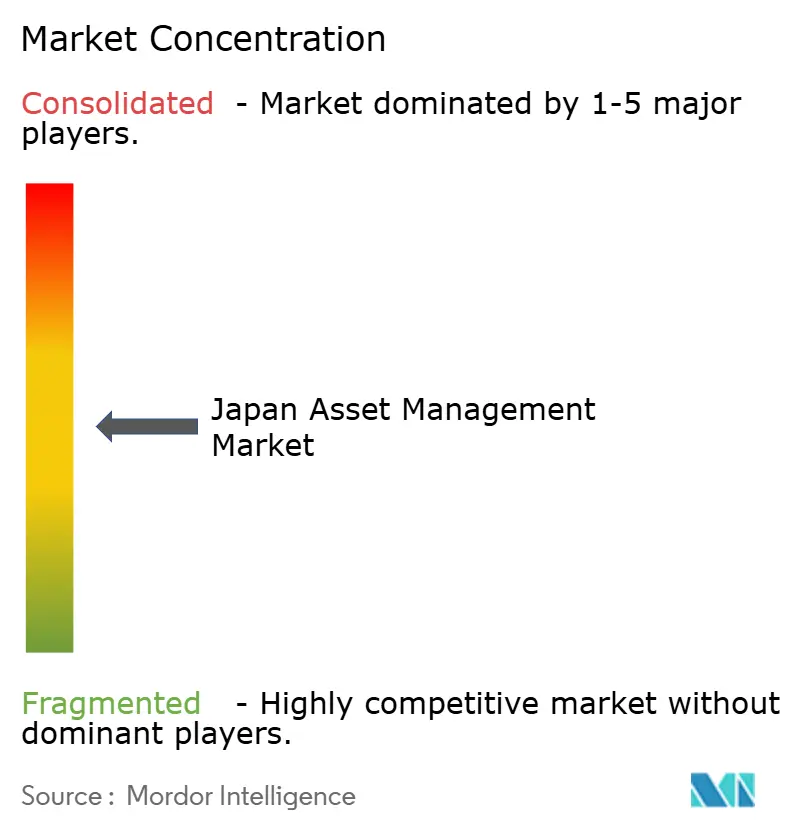
Recent Industry Developments
- April 2025: GPIF allocated USD 500 million to a Thoma Bravo private-equity fund, Pensions & Investments.
- April 2025: Nomura closed its USD 1.8 billion purchase of Macquarie’s public-asset business Nomura Holdings.
- December 2024: MUFG completed its tender-offer acquisition of WealthNavi for USD 664 million MUFG Bank.
- November 2024: SBI Digital Markets unveiled a framework for cross-border tokenized securities distribution SBI Digital Markets.
Research Methodology Framework and Report Scope
Market Definitions and Key Coverage
Our study defines the Japan asset management market as the value of professionally managed investment portfolios, equity, fixed income, alternatives, and balanced products held for retail and institutional clients and reported in U.S. dollars. According to Mordor Intelligence, assets sourced offshore but run by Japan-based managers are counted, whereas self-directed brokerage accounts, enterprise asset-tracking software, and custody-only mandates are excluded.
Scope Exclusions: Corporate fixed assets, IT/enterprise asset management software, and purely advisory retainers lie outside the market boundary.
Segmentation Overview
- By Asset Class
- Equity
- Fixed Income
- Alternative Assets
- Other Asset Classes
- By Firm Type
- Broker-Dealers
- Banks
- Wealth Advisory Firms
- Other Firm Types
- By Mode of Advisory
- Human Advisory
- Robo-Advisory
- By Client Type
- Retail
- Institutional
- By Management Source
- Offshore
- Onshore
Detailed Research Methodology and Data Validation
Primary Research
Mordor analysts interviewed asset allocators, private bankers, pension trustees, and fintech platforms across Tokyo, Osaka, and Singapore. Dialogues validated fee compression trends, offshore mandate growth to 14.4% of AUM, and stress-tested adoption assumptions for robo-advisers among mass-affluent cohorts.
Desk Research
Our desk work began with tier-1 public data, such as Japan Financial Services Agency disclosures, Bank of Japan household asset tables, Investment Trusts Association monthly AUM, World Federation of Exchanges turnover data, and Morningstar Direct fund-flow dashboards. These series frame baseline pools, gauge trading velocity, and spotlight retail appetite after the revamped NISA scheme drew USD 17 billion in its opening quarter.
To enrich company-level detail, we tapped D&B Hoovers for fee revenue splits, reviewed listed managers' securities reports, scanned Diet white papers on "Asset Management Nation" reforms, and parsed customs statistics to reconcile inbound fund passports. This list is illustrative; many other open and subscription sources were reviewed for cross-checks and clarification.
Market-Sizing & Forecasting
We start with a top-down reconstruction of investable pools: household financial assets minus cash holdings, plus institutional reserves, followed by equity, bond, and alternative allocation ratios that are then adjusted for average mandate outsourcing levels. Select bottom-up checks, sampled manager fee income rolled up with typical basis-point spreads, anchor the ceiling. Key variables include NISA contribution limits, GPIF asset mix shifts, net fund inflows, three-month average TOPIX returns, and yen-USD exchange paths. A multivariate regression, refreshed annually, links these drivers to historical AUM and projects to 2030; gaps in sampled fee data are bridged with regional medians from primary interviews.
Data Validation & Update Cycle
Outputs pass variance screens against independent signals, after which senior reviewers sign off. Models refresh every twelve months, and we trigger interim updates for material policy moves or market shocks before dispatching any client copy.
Why Our Japan Asset Management Baseline Commands Confidence
Published figures rarely align because firms pick different asset buckets, pricing bases, and refresh cadences. We disclose the precise investable pool we model, and we keep currency conversions fixed to the year-average yen rate that practitioners actually book.
Key gap drivers versus other publishers stem from scope drift into physical assets, reliance on gross rather than net AUM, or mixing household savings totals with professionally managed funds, which inflates numbers.
Benchmark comparison
| Market Size | Anonymized source | Primary gap driver |
|---|---|---|
| USD 4.93 trillion (2025) | Mordor Intelligence | |
| USD 4.30 trillion (2023) | Global Consultancy A | Counts tangible and intangible asset-tracking revenue alongside financial AUM |
| USD 6.62 trillion (2024) | Industry Association B | Uses gross manager AUM, double-counts cross-booked mandates |
| USD 7.0 trillion (2024) | Regional Consultancy C | Adds household cash pools and captive self-managed pension assets |
These contrasts show that Mordor's disciplined scope, transparent variables, and annual refresh deliver a balanced, decision-ready baseline investors can trust.
Key Questions Answered in the Report
What is the current value of the Japan asset management market?
The market is valued at USD 4.93 trillion in 2025 and is projected to climb to USD 9.62 trillion by 2030 at a 14.31% CAGR.
Which asset class is growing fastest in Japan?
Alternative assets, including private equity and infrastructure funds, are forecast to expand at a 16.42% CAGR through 2030 as institutions follow GPIF’s diversification lead.
How are robo-advisers impacting the Japan asset management market?
Robo platforms manage a growing slice of retail assets, compounding at 20.23% annually, and pushing incumbents toward hybrid digital-human advisory models.
What role do corporate pension reforms play in asset growth?
Mandatory adoption of defined contribution plans is redirecting significant pension flows to professional managers and stabilizing fee-based income streams.
Why are foreign asset managers interested in Japan?
Regulatory reforms, rising demand for alternatives, and the need for global diversification make Japan an attractive growth venue for firms with specialist capabilities.
How is ESG influencing investment strategies?
GPIF’s ESG benchmarks and the government’s climate bond program are spurring product launches that integrate sustainability factors across public and private asset classes.
Page last updated on:
